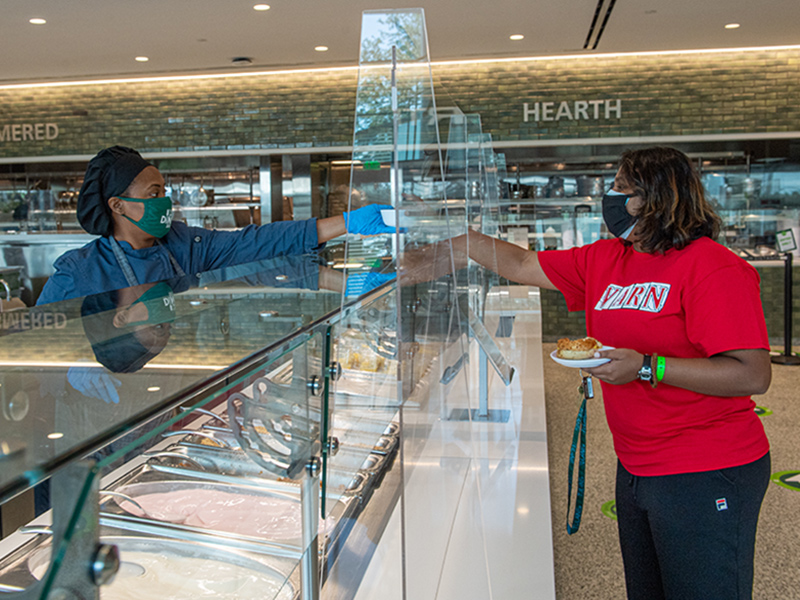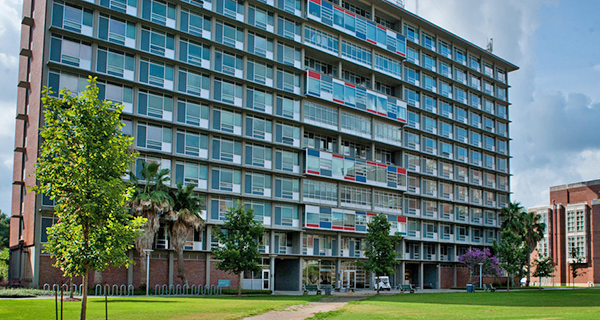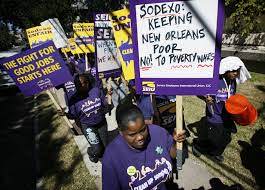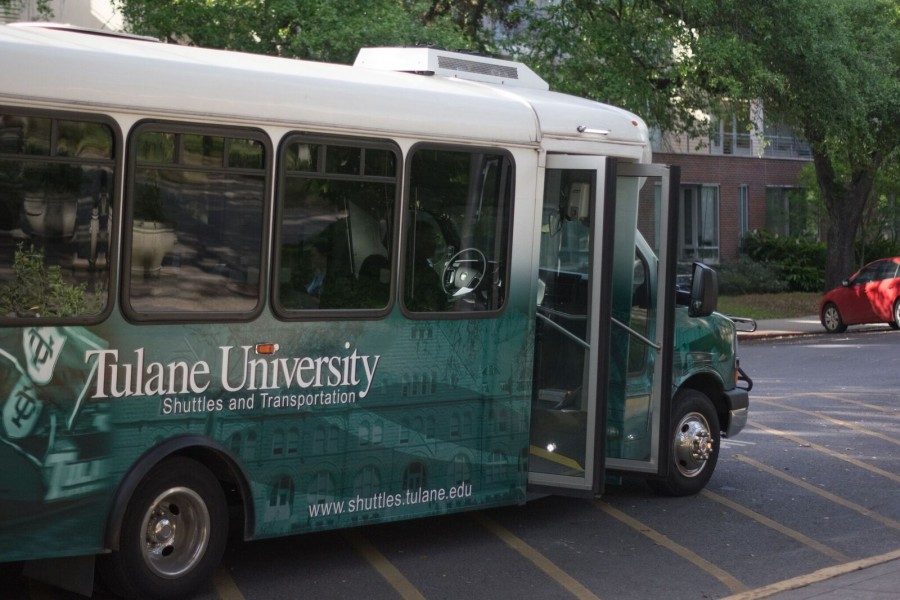Editor’s Note: Taking a page from David Foster Wallace’s “Consider the Lobster,” writers in Kelley Crawford’s Alternative Journalism class at Tulane University chose objects that are rather ubiquitous. Then, they dove into the symbolic narrative those objects tell. Up next in the “Consider the _____” series is the Sodexo Worker.

Tulane Sodexo worker serving food at the Commons (Photo by Sally Asher)
It’s 8:30 AM on a Monday morning. The dread of attending your 10 AM class sets in as the effects of a weekend filled with parties and binge drinking makes its way to the side of your head. This is normal, however, as 43% of undergraduate men and 39% of undergraduate women reported drinking alcohol three or more times each week. You get out of bed and walk down the hall to the communal bathroom to brush your teeth and take a shower. As the warm water hits your skin, you forget for a moment that you’re taking a shower in Monroe, one of Tulane University’s freshman dorms.
After your shower, you get dressed and head to the Commons to have breakfast. At the end of your meal, you walk to the dish return station, place your plates on the conveyor belt and head to your class. You walk along McAlister Ave. heading towards the academic quad. Unlike Saturday night, McAlister is clean, litter free, and the leaves are blown to the sides of the street. Finally, you cross Freret, and head inside the Lindy Boggs Energy Center, to attend your 10 AM physics class. After your morning classes, you go back to your dorm and do homework for two hours. Later in the day, you meet with your group to work on the group project that you have due tomorrow. Around 6:30pm, you get dinner at the Commons, and once you finish eating, you go back to your dorm and unwind for the day, ready to repeat the process tomorrow.
As a student at Tulane, it’s very easy to carry on without realizing how much goes on behind the scenes to make your life as easy as possible. When I was a freshman at Tulane, I grew very close to one of the Sodexo workers that worked in Monroe, and he would tell me all of the nasty inhumane things that he would have to do. For the sake of protecting his job, let’s call him John.

Tulane’s largest freshman dorm Monroe (Photo by Tulane Housing)
Since the ring of your alarm, to the minute you entered your physics class, people like John showered your world with comfort at the expense of underpayment and systemic racism. See, the bathroom that you showered in didn’t magically clean itself. John woke up at the 5:00am and arrived at the University ready to start his shift. He started by cleaning the 7th and 8th floor bathrooms, and then arrived at your floor. He picked up every crumpled-up paper towel and emptied the overflowing trash can. He then opened the stall door and accepted what the next 10 minutes of his life would entail. He hand-wiped the toilet, scrubbed at the vomit that had crusted around the edges of the stall, and sprayed it with Clorox. After he mopped the floor, he worked on the sinks. He wiped them down with Clorox, ridding them of beard shavings. He went over to the third sink and removed the half-eaten ramen noodles which were stuck in the pipe before finishing off by wiping down the showers.
Over at the Commons, the sleep deprived Sodexo workers at the University start their shifts as by washing food, cleaning dishes, and setting up. While some of the workers prepare the food, others clean the tables and chairs. The floors are mopped, and the bathrooms are cleaned. From 7 AM to 10 PM, the Sodexo workers at the Commons serve students food and make sure their dining experience is as pleasurable as possible. Throughout campus, other Sodexo workers can be found picking up trash and blowing leaves off of McAlister Ave. For all of their hard work, you’d think that they would be compensated decently right? Wrong.
Sodexo is a French food services and facilities management company. It has over 400,000 employees and is present in over 80 countries. 47% of its annual $20 billion in revenue comes from North America and Sodexo is the primary food service provider for over 400 school districts throughout the United States. Sodexo only pays their Tulane employees $8 per hour. In fact in 2010, Sodexo workers at Tulane staged a one day walkout to protest their unfair wages. The workers marched around Tulane’s campus and rallied at its student center. Even students at Tulane helped petition to get Sodexo to allow the workers to form a union. All of these efforts however, have been futile.

Dozens of Tulane Sodexo workers participating in the walkout to protest unfair wages (Photo by Rusty Costanza)
To add fuel to the fire, Tulane prohibited Sodexo workers from being able to ride the shuttle service. Many of the Sodexo workers rely on public transportation to get to and from work. It was only after the work of students and student organizations had caught the eyes of administration and staff did Tulane reinstate their shuttle privileges. The primary argument by these student activists for Sodexo was that Tulane actively discriminates against service workers on its campus by denying them benefits that are provided to other staff and faculty. The most vocal student organization fighting on behalf of the Sodexo workers was the Black Student Union (BSU).

Tulane Shuttle that Sodexo workers were prohibited from taking (Photo by Colin Yaccarino)
If you take one look at Tulane’s campus it is very easy to notice the lack of diversity in the student/faculty population. After going to the LBC (Lavin Bernick Center) 3 days in a row, I counted the ratio of black to white workers. I found that the ratios were 14:0, 12:0, and 12:0 respectively. I went to the Commons as well and I only saw 3 workers who were not black. Majority of the African Americans at Tulane’s campus are, in fact, Sodexo workers, which is why the BSU argued that “Tulane should demonstrate its commitment to race and class diversity by … allowing Sodexo workers to ride the University shuttles to and from work.” Although the shuttle riding privileges were reinstated to Sodexo workers, the racial disparity at Tulane has barely been addressed. Why is it okay to cast aside a group of people who are central to making your University look pristine and attract thousands of students across the country? Even though Tulane doesn’t have control over how Sodexo treats their employees, Tulane does have control over how they treat Sodexo employees.
 NOLAbeings Multimedia artist Claire Bangser created NOLAbeings as a portrait-based story project that marries...
NOLAbeings Multimedia artist Claire Bangser created NOLAbeings as a portrait-based story project that marries...  Voodoo in New Orleans: Reviving history: New Orleans fortune telling This article takes a deep dive into the history of Voodoo in New Orleans, its hybridization with Catholicism, and its present-day place in the city's culture. The author visits fortune-tellers in the French Quarter, using their guidance as a tool for introspection rather than a deterministic predictor of the future. Through her experiences in New Orleans, the author feels a mystical connection to both the past and the future.
Voodoo in New Orleans: Reviving history: New Orleans fortune telling This article takes a deep dive into the history of Voodoo in New Orleans, its hybridization with Catholicism, and its present-day place in the city's culture. The author visits fortune-tellers in the French Quarter, using their guidance as a tool for introspection rather than a deterministic predictor of the future. Through her experiences in New Orleans, the author feels a mystical connection to both the past and the future. 